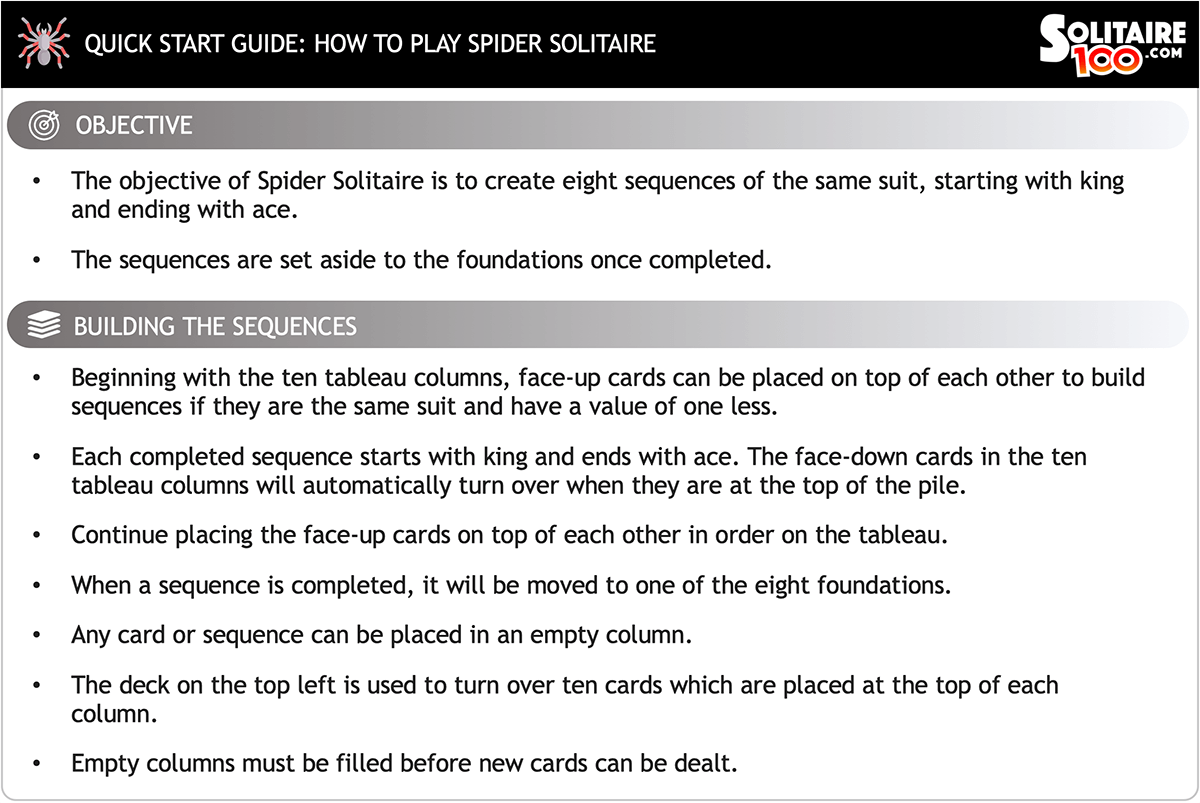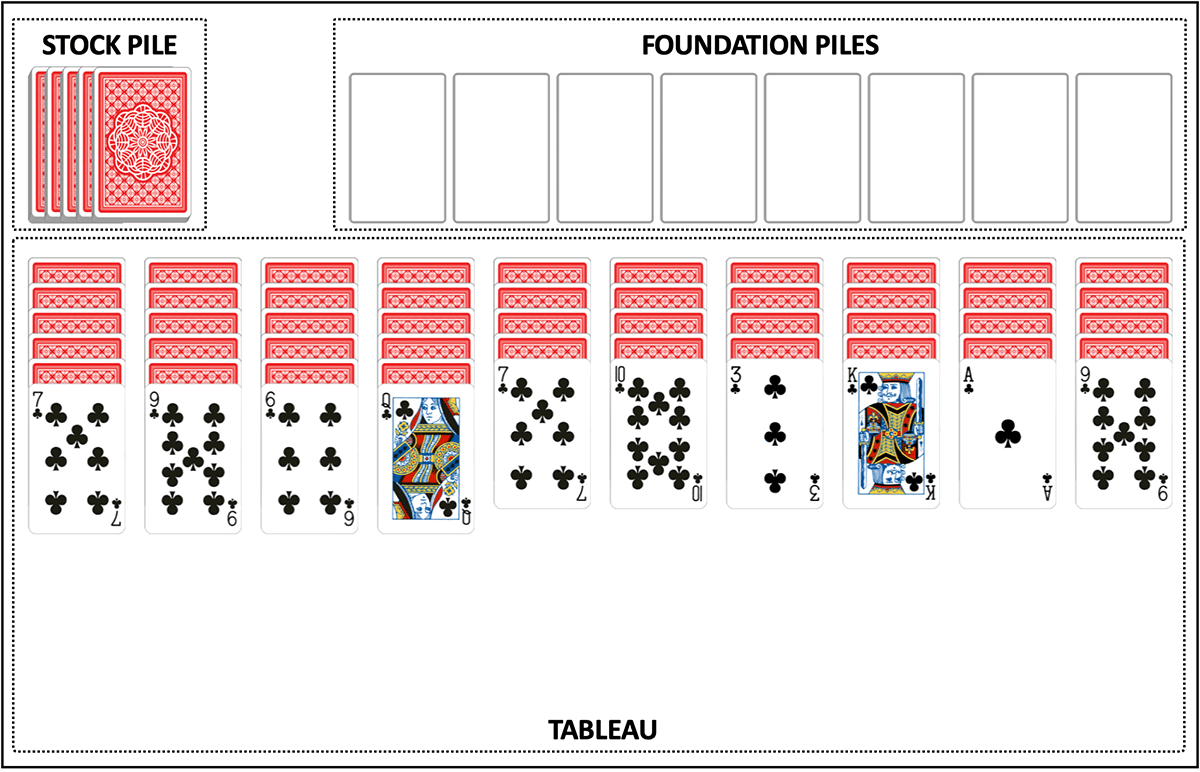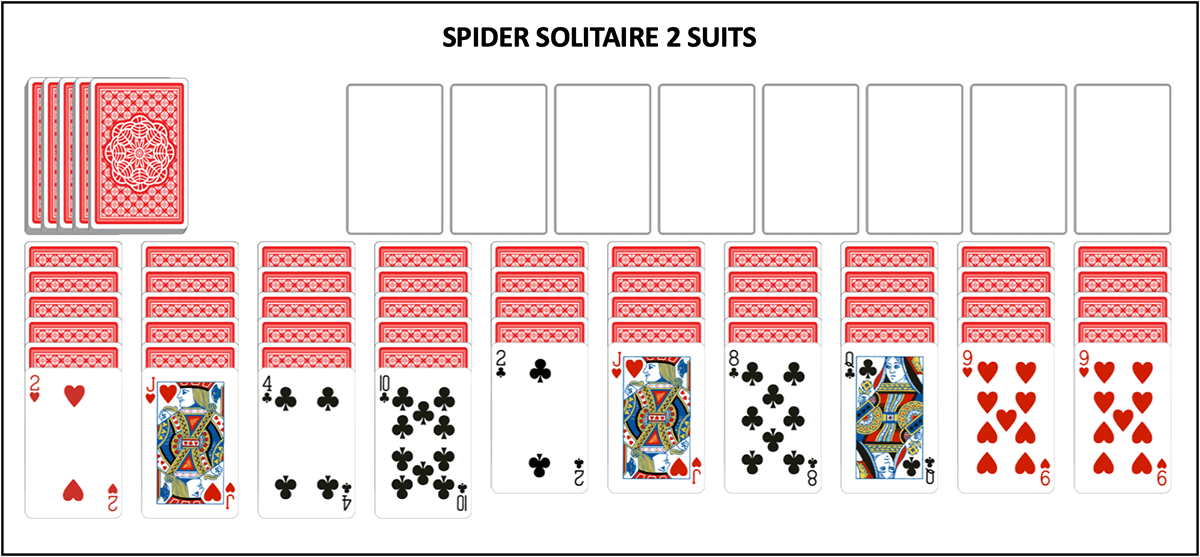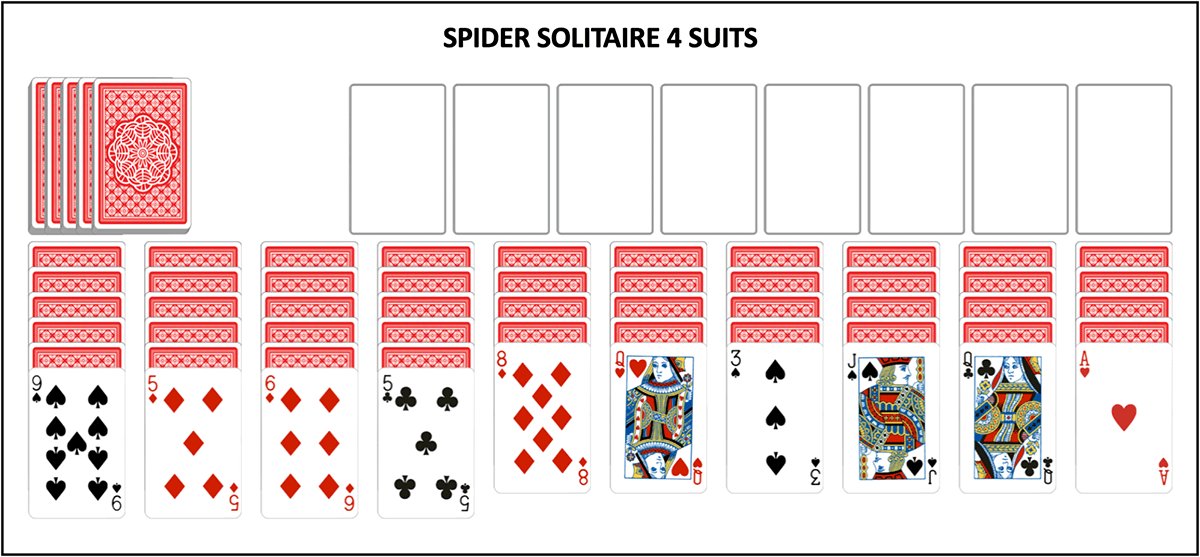Free Spider Solitaire (1, 2 and 4 Suits) : Play Online, How To Play & More!
Solitaire itself dates back to the 18th century and beyond. Around the world, it has acquired a variety of names: Patience in Britain to Klondike in Canada and the US. With the advent of modern computing, solitaire became one of the most popular games available, with millions of users worldwide. As opposed to the traditional form of Classic Solitaire, several notable variations of the game have become increasingly popular: FreeCell to Pyramid Solitaire, and of course, Spider Solitaire. If you want to play free Spider Solitaire 1 Suit, 2 Suits or 4 Suits, scroll up and get started playing Spider Solitaire online! If you want to discover more about the eight-legged game including Spider Solitaire rules and how to win Spider Solitaire, read on.
Named for the eight columns of cards laid out on the tableau, Spider Solitaire requires at least two decks, with the game using a total of 104 cards. There is more to Spider Solitaire than meets the eye, from an engaging history to mathematical marvels.
How To Play Spider Solitaire (Easy Spider Solitaire Rules)
Check out the diagram below for a quick start guide on how to play Spider Solitaire. For more detailed rules, keep reading.

How To Win Spider Solitaire
The aim is to assemble all 13 cards of a suit, from ace to king, into one pile. With two decks of cards, there are eight suits to compile. You win when all eight piles are complete.
Spider Solitaire Rules
To begin, you can move any of the top cards in a pile, as well as any other face-up cards that form a continuous sequence, for example, 6, 5, 4, 3 or Q, J, 10, 9, 8, 7. When moving card(s) from one pile to another, you must lay them down on a card with the next-highest value, so a queen can be put on a king, but not on a jack. The suit of the card does not matter. As face down cards become the top card, they turn over.
Once a sequence from king to ace is complete, it is removed from play. If a free space opens up, any card or card set can be put into the free space.
When you are unable to move any more cards, deal another row from the stock pile so a new card is put face up on every pile. However, to deal out cards, none of the spaces can be empty before you deal.

Score
The highest score for free Spider Solitaire by SOLITAIRE100 is 215 points. You will earn 5 points every time a face-down card is turned up. The undo function is there to help you if you get stuck or would like to go back some moves (it will allow you to do this indefinitely!), but be careful, as you will lose 5 points every time undo is used. Try to complete the game and achieve the perfect score of 215 and then focus on completing the game in the quickest time possible. This is the best way to perfect your skills and become a master of Spider Solitaire.
Spider Solitaire 1 Suit
Now you know how to play Spider Solitaire, let’s explore a few variations. The Spider Solitaire rules depend on the number of suits used in the game.
In this version, ignore the suit of the cards. Follow the Spider Solitaire rules as described above.
Spider Solitaire 2 Suits
Deal the cards out as described above; however, you will need to focus on matching reds with reds, and blacks with blacks. You can only move clusters of the same colour; although, cards can still be put on top of any card of the next-highest value. So, you can place a 6 of clubs on a 7 of diamonds, but they cannot move together.

Spider Solitaire 4 Suits
Deal the cards out as described above. However, this time you will need to match each suit with itself. It follows the Spider Solitaire rules as described in the 2 Suits version, except you can only move sets of cards with the same suit. With Spider Solitaire 4 Suits, the game is exceptionally strategic, requiring you to plan ahead as one wrong move could prevent you from winning the game.

How To Set Up Spider Solitaire
Two standard 52-card decks will get you started. Spider Solitaire differs from the classic game in several important ways. When dealing, lay down ten piles of cards face down, the first four piles should contain five cards, and then the next six piles should contain four cards. Then deal another card to each of the ten piles on top, facing up.
Place the rest of the cards in the left-hand corner of the table, this is your stock pile. Don’t forget, when you’re making a sequence during game play, place each card slightly lower than the card below so that you can see the suit of each card. Also, when you deal out the final cards, there will only be four remaining cards; these are put on the first four piles.
Free Spider Solitaire Online
You can enjoy free Spider Solitaire card games online at SOLITAIRE100.com. Play free Spider Solitaire 1 Suit, Spider Solitaire 2 Suits, and Spider Solitaire 4 Suits on any device, any orientation, and without having to download anything or sign up. The 3 versions of free Spider Solitaire are of varying difficulty so you can track the progress of your skills.
We have removed the clutter from the design of the game so enjoy a modern version of the classic game. It’s smooth to play and looks great on mobile, tablet, and desktop.History Of Spider Solitaire
Pieces Of Eight
Solitaire itself has a range of origin stories, with everywhere from Germany, Scandinavia and France claiming to be the homeland of the popular game. In one such tale, a French prisoner during revolution devised the game to pass the time. Indeed, many of the words we use even today to describe solitaire come from French.
Nonetheless, since its inception, there have been many variants. Spider Solitaire was one such variation, which predates many of the others, being first mentioned in 1917, in ‘Culbertson's Card Game Complete with Official Rules’. The manual is by Ely Culbertson who, at the time, was a famous and celebrated American bridge player. Historically, many are unsure whether he invented the game, or was simply the first to put ink to paper. Either way, from then on Spider Solitaire had become one of the classics of the genre.
8-Bit Game
In 1989, solitaire first became commercially available under the brand 'Solitaire Royale'. Brad Fragger, from Montana, US, developed the game for PCs, Amiga, and even Apple Macintosh computers. However, for fans of the spider, they would have to wait another three years. In 1992, Quantum Quality Productions released 'Solitaire Journey' which included 105 different versions of the game, one of which was Spider Solitaire.
However, such games packages were the province of but a few. Solitaire itself had been a backroom parlour game for years. Still, it had faded out of popularity throughout much of the twentieth century. It wasn't until Microsoft introduced a version of Classic Solitaire or Klondike, on Windows 3.0 in 1990 that the game found new life.
In 1995, they added FreeCell to the mix, and then finally with Windows 98’s Microsoft Plus! Package Spider Solitaire was properly introduced to the world. From then on, except for Windows 2000, all later Windows systems included Spider Solitaire as standard. However, it would be Windows XP’s version of the game that fans fell in love with, with many still considering it amongst the best versions ever produced.
On the World Wide Web
John A. Junod created an early version of the game for Windows 3.x back in 1991, with a final version for Windows Spider Solitaire being version 92.01.04. Ian Heath, a professor of computer science at the UK's University of Southampton, produced a similar game known as Arachnid. It was made for Windows 3.x, also in 1991. Arachnid was later rewritten for 32-bit operating systems, being renamed Arachnid 32.
Meanwhile, by 2005, Spider was the most played game on Windows PCs, outshining even the classic and original Windows Solitaire. Windows Vista introduced a new version of the game, which remained mostly unchanged upon the release of Windows 7. With the rise of the Windows Store, Microsoft amalgamated Spider Solitaire with all other versions into the Solitaire Collection.
Following on from the success of Spider Solitaire on the Windows system, many companies and amateurs got in on the act, producing their own versions of the game.
Variations Of Spider Solitaire
In just the same manner that Spider Solitaire was a spin-off or offshoot from the original Classic Solitaire, so too has Spider Solitaire developed its own variations. These include:
Spider 1 Or 2 Suits
As we know, instead of using 4 suits, players can use either 1 suit or 2 suits. Reducing the suits simplifies the game.
Relaxed Spider
In this version, players do not need to fill the empty spaces before the deck can deal.
Spiderette
As opposed to using two decks of cards, in Spiderette, there is only one deck in use. The cards are set up similarly to Classic Solitaire. There are only seven foundations.
Spiderwort
This version uses three decks of cards, totalling 156 cards. There are 13 tableau piles, with 71 cards dealt into each pile (there are six cards in the first six piles and five cards in the remaining seven piles). As in regular Spider, the top card of each pile is face up.
Will O’ The Wisp
Invented by Geoffrey Mott-Smith, the game is similar to Spiderette. However, it differs, in that you deal only twenty-one cards into seven columns of three, with the top card face up.
Simple Simon
Similar to Spiderette, Simple Simon uses only one set of 52-cards. Deal the cards into three columns of eight cards, then each of the subsequent seven columns decreases the number of cards by one card until the last column only has one card. From then on, the same rules apply as regular Spider, with a player attempting to get a run of the same suit in sequence from king down to ace.
Mrs Mop
Invented by Charles Jewell, a distinguished philatelist, players use two packs of cards to deal into thirteen columns of eight cards. As in Spider, the aim is to create eight sequences of each suit consisting of thirteen cards from king to ace. However, it is widely considered to be more difficult than Spider, with a completed game being incredibly rare.
What Is The Win Rate Of Spider Solitaire?
According to Steve N. Brown, writing in his book 'Spider Solitaire Winning Strategies', players can win over 45 per cent of all games. However, they must be playing with four suits, without restarting the game, undoing moves, or rejecting games. He reported a win rate of 48.7 per cent over 306 games, with expert players perhaps hoping to achieve an even higher level of fifty to sixty per cent. However, an average player can expect to win around 30 per cent of games.
When playing a version from one of the Windows releases the highest possible score is 1254. You can calculate the score by taking an initial score of 500 and subtracting every subsequent move from the score. Using the 'undo' feature will also deduct from the score. However, once a player has created an entire sequence of cards from king to ace, you can add 100 points to the score. As they are eight such sequences, then a total of 800 points are achievable. Therefore, the end score is 500 plus 800, minus however many moves it took the player to complete the game.
So, how did we get to 1254?
Well, add 500 and 800 together, and you get 1300. However, no one, not even the very best players, can complete a tableau in no moves. Therefore, we must work out what are the least possible moves you can make. To build eight suits, you must move 12 cards, totalling 96 moves, which would give a player a score of 1204. Yet, one can imagine an incredibly lucky unicorn of a tableau, in which, each of the five deals lands on exactly the right card, e.g. a five of clubs on a six of clubs. None of these cards need to move, thereby gaining 50 points, giving a final score of 1254.
In reality, no one has ever had such luck. According to the World rankings for Spider Solitaire, in which 935 players submitted 2,563 games, the highest score was 1197 points. Amazingly, 50th place was only a few points behind at 1122. It isn't a formalised tournament. Nor is it a system to identify the best players in the world; however, it does provide an insight into the level high-quality players can achieve.
Is Spider Solitaire Rigged?
It might surprise you to find out that many players have accused various software programs of Spider Solitaire of being rigged. If a player has a high win rate, subsequent deals will be harder, thereby 'rigging the cards' – or so the allegation goes. It may well be the case that players find themselves naturally fluctuating in their ability from game to game. They may even overcompensate in a particular strategy if it works for multiple games, only to suddenly hit a wall.
However, is there any truth to the claims?
Dr Trevor Tao, a research scientist and applied mathematician, set to work solving this conundrum for Plus magazine back in 2018. As he noted, an ideal deal should work in the same manner as if done manually on a table top, given that perfect shuffling had taken place.
Dr Tao goes on to explain that the chance of each card appearing is a fraction of all the cards available. If you were playing with a 52-card deck, then the possibility of a specific king appearing, for instance, the king of hearts, would be 1/52. Whereas when using two decks, the chance is 2/104 (which is still 1/52). However, the possibility of a king appearing is 8/104, as there are eight kings in the 104 cards, or 1/13.
Therefore, with ten cards initially exposed, the chance of an exposed king is 10 x 1/13 or 10/13. If a king appeared more commonly, say 11/13, then the game can be said to be biased, as starting with kings is the most challenging opening.
Following a careful analysis, and 100 games later, Trevor found that although he did worse on the games than expected, his mediocre performance wasn't statistically significant. Thus, the game could not be considered biased.
Hardly, a nail in the coffin of the argument, but it’s the best attempt to test the theory to date.
Tips And Tricks For Spider Solitaire
Of all solitaire games, Spider Solitaire is amongst the trickiest. Unlike a game like FreeCell, where almost every game is winnable, with Spider Solitaire players are never quite sure if they'll be able to complete a game. However, there are some essential tips to remember, to ensure the odds are always in your favour.
1. Always play the best move
You might think this goes without saying, however, in Spider Solitaire you may end up stuck between a rock and a hard place, with no right moves to make. In such situations, try and play the move that does the least damage or which will most likely lead to victory.
2. Order is everything
In some games, playing efficient moves is all that matters. However, in Spider Solitaire, the order in which you complete the tableau is critical. Placing cards in the wrong order can determine whether you win or lose a game. Study the tableau and work out whether you can achieve more by taking a longer route. For instance, you might be able to reveal more hidden cards in five moves than you can in three.
3. Be purposeful
Just because a move is obvious, doesn't make it right. Sometimes it pays not to make a specific move. It is better to unlock the hidden cards or unlock an empty column than to stack cards of the same suit. The game revolves around such situations, and often, only the most experienced players can make the correct call.
4. Open cards are your best resource
If you have an open card, aside from an ace, then further cards can be put on top of it. Therefore, each free space is a resource that once used is gone—as such, only place cards on top of others if it leads to victory. As with everything in life, don't waste resources you can't get back.
5. Vacant columns are key
Upon vacating a column, you face a tricky decision, deciding what to place in the open space. It can be a valuable opportunity to move cards around the tableau, creating greater stacks of each suit. Before proceeding, make sure you have devised a game plan for at least the following few moves to make the best use of the opportunity.
6. Unlock your kings
It is a recommendation that kings are only placed into an empty column once two empty columns have been achieved. However, sometimes you have a plethora of kings that are slowing the game. In such cases, it can be sensible to 'extract' the kings, placing them in an empty column. Often this is the last hurrah in a game as a player finds themselves on a losing path. But it can work sometimes; it just takes the skill to know when.
7. Leave a card under a king
If there are a couple of hidden cards left under a king, many players are eager to move the king into an empty column, to bring the cards into play. A newly turned card is often placed soon afterwards, thereby opening yet another vacant column. However, this can cause problems in game play if the card cannot be placed, and if there is only one card beneath a king, then it can be best to leave in place.
8. Deal when you have to
A fundamental rule to remember is that unless forced to, do not deal. Always check there are no other possible moves that can be made before dealing out ten cards.
9. Don’t always build a suit
Despite being the eventual aim of the game, building by suit can create a cul-de-sac of options. Therefore, it can be sensible to place a card on a different suit to open up your options. It might even be in your interests to not complete a finished suit, leaving open the possibility of stacking cards on top. However, if the suit is in a vacant column, you have neither lost nor gained anything, and it is worth making the play.
The most important rule when playing Spider Solitaire is practise, practise, practise. The more games you play, the more patterns you will see. If you are a beginner, start with a 1 Suit or 2 Suits game. Spider Solitaire 4 Suits games can be especially tricky, so wait until you're ready. It might even be worth trying out one of the variations of the game, especially for expert players. Otherwise, enjoy!
Don’t forget, you can practise free Spider Solitaire as much as you want at SOLITAIRE100.com!
Sources:
https://en.wikipedia.org
https://ezinearticles.com
https://en.wikipedia.org
https://answers.microsoft.com
https://plus.maths.org
https://en.wikipedia.org
https://hubpages.com
https://ourpastimes.com